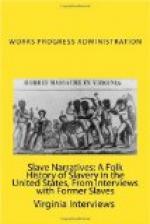“I remember well the day that Dr. Nellum, just as if it were yesterday, that we went to the court house to be set free. Dr. Nellum walked in front, 65 of us behind him. When we got there the sheriff asked him if they were his slaves. The Dr. said they were, but not now, after the papers were signed we all went back to the plantation. Some stayed there, others went away. I came to Baltimore and I have never been back since. I think I was about 17 or 18 years old when I came away. I worked for Mr. Marshall, a flour merchant, who lived on South Charles Street, getting $6.00 per month. I have been told by both white and colored people of Virginia who knew Dr. Nellum, he lost his mind.”
Maryland
Sept. 29, 1937
Rogers
Rev. Silas Jackson, Ex-slave.
Reference: Personal interview with Rev. Silas
Jackson, ex-slave,
at
his home, 1630 N. Gilmor St., Baltimore.
“I was born at or near Ashbie’s Gap in Virginia, either in the year of 1846 or 47. I do not know which, but I will say I am 90 years of age. My father’s name was Sling and mother’s Sarah Louis. They were purchased by my master from a slave trader in Richmond, Virginia. My father was a man of large stature and my mother was tall and stately. They originally came from the Eastern Shore of Maryland, I think from the Legg estate, beyond that I do not know. I had three brothers and two sisters. My brothers older than I, and my sisters younger. Their names were Silas, Carter, Rap or Raymond, I do not remember; my sisters were Jane and Susie, both of whom are living in Virginia now. Only one I have ever seen and he came north with General Sherman, he died in 1925. He was a Baptist minister like myself.
“The only things I know about my grandparents were: My grandfather ran away through the aid of Harriet Tubman and went to Philadelphia and saved $350, and purchased my grandmother through the aid of a Quaker or an Episcopal minister, I do not know. I have on several occasions tried to trace this part of my family’s past history, but without success.
“I was a large boy for my age, when I was nine years of age my task began and continued until 1864. You see I saw and I was a slave.
“In Virginia where I was, they raised tobacco, wheat, corn and farm products. I have had a taste of all the work on the farm, besides of digging and clearing up new ground to increase the acreage to the farm. We all had task work to do—men, women and boys. We began work on Monday and worked until Saturday. That day we were allowed to work for ourselves and to garden or to do extra work. When we could get work, or work on some one else’s place, we got a pass from the overseer to go off the plantation, but to be back by nine o’clock on Saturday night or when cabin inspection was made. Some time we could earn as much as 50 cents a day, which we used to buy cakes, candies, or clothes.




